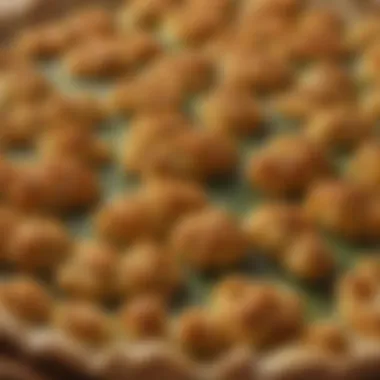Nutritional Benefits of Cauliflower Pizza Crust


Intro
In recent years, the culinary landscape has undergone a notable transformation. With the rise of plant-based diets, many folks are rethinking their dietary choices, especially when it comes to beloved comfort foods like pizza. Non-dairy cauliflower pizza crust has become a fixture in this paradigm shift, presenting an appealing option for those keen on maintaining a healthy lifestyle without sacrificing flavor.
A fascinating twist on a classic, this innovative crust caters to a wide range of dietary preferences and restrictions. Whether you’re a health enthusiast or a busy parent looking to sneak in some veggies for the kids, non-dairy cauliflower pizza crust is worth considering.
This exploration aims to examine the nutritional benefits and various culinary applications of cauliflower pizza crust. Beyond mere substitution for traditional dough, it opens up a world of flavors and textures that can cater to diverse palates. Let’s unpack the layers of this trend and uncover the delicious possibilities that await.
Wellness
Nutrition and Diet
Potentially packed with vitamins and minerals, non-dairy cauliflower pizza crust is a nutrient-dense alternative to regular pizza dough. Cauliflower itself is low in calories and high in vitamins C, K, and fiber. This substitution not only makes for a healthier meal, but it also serves as a gateway for incorporating more vegetables into your diet.
- Low Carbohydrate: For those on a ketogenic diet, this crust is a solid choice as it significantly lowers carbohydrate intake compared to conventional flour-based crusts.
- Gluten-Free: Many people are sensitive to gluten, and cauliflower provides an excellent base that avoids this common allergen.
- Fiber-Rich: The fiber content in cauliflower also helps in digestion, promoting a sense of fullness, which can contribute to weight management.
Fitness and Exercise
Integrating nutritious meals like cauliflower pizza into your diet can complement a fitness regimen. A well-balanced intake of calories and nutrients is crucial for optimal energy levels, whether you’re hitting the gym or going for a leisurely walk. Combining non-dairy cauliflower pizza with a side salad or veggies can help keep your meal balanced and satisfying without heavy calories.
"Health isn’t just about what you eat, it’s about what you don’t eat," emphasizes the idea of mindful nutritional choices.
Mental Health
Feeding the body with wholesome foods also impacts mental well-being. A diet rich in vegetables can contribute to better mood and cognitive function. This pizza crust allows you to enjoy a favorite meal while promoting overall wellness. Engaging in a healthy eating pattern can be empowering, leading to improved self-esteem and a positive relationship with food.
The shift towards plant-based options, including cauliflower crust, fosters an environment for mindful eating. It encourages individuals to engage with their meals, savoring each bite while reflecting on their culinary choices.
As families seek to support one another in adopting healthier habits, non-dairy cauliflower pizza serves as a fun and tasty focal point for shared meals. After all, eating well shouldn’t feel like a chore—it can be an exciting venture into a world of flavors that leave everyone satisfied.
Culmination
In diving into the world of non-dairy cauliflower pizza crust, you’re not just exploring a food trend; you’re embracing an opportunity to enhance your nutrition, foster better eating habits, and enjoy the art of cooking. Whether it's for health, taste, or simply seeking to try something new, this culinary shift invites everyone to take part in the delicious directive of cooking with plant-based ingredients.
Prelims to Non-Dairy Cauliflower Pizza Crust
In recent years, there’s been a surge of interest in non-dairy alternatives, particularly when it comes to beloved dishes like pizza. The introduction of cauliflower pizza crust not only meets dietary needs but also satisfies a craving for something familiar yet elevated. This section explores the significance of this culinary innovation, emphasizing its relevance in today’s health-conscious society.
Among the clear advantages of cauliflower pizza crust is its ability to cater to various dietary restrictions. For those who avoid dairy—be it due to lactose intolerance, veganism, or simply a desire for healthier choices—this crust offers a tasty solution without compromising on flavor. Moreover, incorporating cauliflower into our diets can lead to a more nutrient-rich meal, allowing diners to indulge in pizza guilt-free.
Another vital aspect of non-dairy cauliflower pizza crust is its role in the broader movement toward plant-based diets. Many people are moving away from traditional animal-based products, preferring to experiment with ingredients that are not only better for personal health but also for the environment. Cauliflower acts as the perfect foundation for this type of dish—it's versatile, approachable, and chock-full of benefits.
As we delve into the various layers of this culinary creation, we will highlight important elements such as preparation techniques, nutritional benefits, and potential flavors. Joining the ranks of comfort food with a nutritious twist, cauliflower pizza crust could be a game-changer for families and culinary enthusiasts alike.
The Shift Toward Plant-Based Diets
The past few years have witnessed an unprecedented shift in eating habits, with many people gravitating towards plant-based diets. This isn’t a mere trend; it reflects a broader understanding of the connection between diet and overall well-being. As studies reveal the environmental impact of meat production, more diners are choosing to explore alternatives.
This movement is often driven by a desire for healthier eating, whether for weight management or reducing the risk of chronic diseases. Foods like cauliflower, which are low in calories but high in nutritional value, fit perfectly into this shift. Plus, they provide ample opportunities for culinary creativity.
Some might think swapping traditional pizza for a cauliflower crust is too drastic, but the truth is that it opens up a world of fresh possibilities. Imagine a scenario where your family gathers around the table, and instead of the usual pizza dough, they are treated to a delicious, flavorful cauliflower-based crust. Not only does it taste great, but everyone feels good about the choices made.
Understanding Cauliflower as a Culinary Ingredient
When it comes to versatility in the kitchen, few ingredients rival cauliflower. Once deemed a humble vegetable, it has recently taken center stage as a beloved element in countless dishes. Its mild flavor allows it to absorb surrounding spices and ingredients, making it a chameleon of the culinary world.
The texture of cauliflower also lends itself well to becoming a pizza crust. When riced and prepared correctly, it can mimic the feel of traditional dough, providing a satisfying base without the heavy calories. This ability to transform is crucial for anyone looking to enjoy their favorite foods while embracing healthier lifestyle choices.


Additionally, the nutritional profile of cauliflower is impressive. Not only is it low in calories, but it’s also packed with vitamins C, K, and B6, along with folate, manganese, and potassium. For parents keen on nourishing their families, incorporating cauliflower into their meals can improve dietary intake while exploring creative ways to engage children with veggies.
In summary, understanding cauliflower as both an ingredient and a dietary choice reveals its potential beyond just being another vegetable. It represents a shift towards innovative, healthful eating that resonates with many individuals today.
Nutritional Benefits of Cauliflower
When it comes to reimagining pizza crusts, few ingredients can hold a candle to cauliflower. This versatile vegetable has surged in popularity, especially in the wake of the burgeoning shift towards healthier eating habits. It’s not just about finding alternatives to traditional wheat-based crusts; it’s about embracing the numerous nutritional benefits that cauliflower has to offer. In this section, we will delve into the low-calorie, high-fiber nature of cauliflower as well as its rich spectrum of vitamins and minerals, solidifying its status as a superfood in the plant-based culinary landscape.
Low-Calorie and High-Fiber Content
Cauliflower is a powerhouse of low-calorie goodness. With only about 25 calories per cup, it is an ideal choice for anyone looking to trim calories without sacrificing satisfaction. When compared to conventional pizza crusts, which can easily clock in at hundreds of calories per serving, choosing a cauliflower crust is a step in the right direction for those aiming to maintain or lose weight.
Furthermore, one of the standout features of cauliflower is its fiber content. A single serving provides roughly 2 grams of fiber, contributing to digestive health and promoting a feeling of fullness. This means you're less likely to overindulge at meal times. The incorporation of high-fiber foods like cauliflower into your diet can also assist in managing blood sugar levels, making it a smart choice for those who are pre-diabetic or simply looking to maintain steady energy throughout their day.
Vitamins and Minerals in Cauliflower
Cauliflower doesn’t just wear its low-calorie badge proudly; it also boasts a cocktail of essential vitamins and minerals that are vital for maintaining good health. Rich in vitamins C and K, this vegetable plays a crucial role in immune function and bone health.
- Vitamin C: It’s not just for warding off colds; this vitamin is instrumental in collagen production, vital for healthy skin and joints. It also acts as an antioxidant, battling free radicals that could potentially harm your cells.
- Vitamin K: This nutrient is key for blood clotting and supports bone health. A serving of cauliflower can cover a significant portion of your daily requirement.
- B Vitamins: Cauliflower is a source of several B vitamins, particularly folate. Folate has essential roles in DNA synthesis and repair as well as red blood cell formation.
“Including cauliflower in your meals can help reinvigorate both your health and your dining experience.”
In summary, opting for cauliflower as a base for pizza crust not only aligns with dietary preferences but also infuses your meal with a hefty dose of nutrition. This vegetable, which is often overshadowed by more common pizza toppings, deserves a rightful place at the heart of a health-conscious kitchen.
Making the Cauliflower Crust
Creating a non-dairy cauliflower pizza crust isn’t just a passing trend; it’s a shift towards healthier, plant-based nutrition. This section will unpack the critical aspects of making the crust that not only caters to dietary preferences but also elevates the overall pizza experience. Understanding the key steps—from selecting fresh ingredients to perfecting the baking process—will make your cooking journey both enjoyable and fulfilling.
Selecting Fresh Ingredients
When crafting a cauliflower crust, the quality of your ingredients can make or break the dish. Fresh cauliflower is essential because it provides the main structure and flavor. Look for heads that are firm and free of blemishes. The greener the leaves attached, the fresher the cauliflower tends to be.
In addition, consider incorporating herbs and spices as you traverse your culinary path. Using fresh basil or oregano, for example, can dramatically enhance the taste profile of your crust. The benefits of using fresh produce include richer flavors and better nutritional value, leading to an overall delightful pizza creation.
Preparation Techniques
Ricing Cauliflower
Ricing is an important step in making cauliflower crust, as it transforms the vegetable into a texture similar to traditional pizza crust. To rice cauliflower, you simply break it down into small grains using either a food processor or a box grater. This creates more surface area, allowing for better absorption of flavor and even cooking.
One of the key characteristics of ricing cauliflower is the ability to control the size of the grains. Finely riced cauliflower leads to a smoother crust but may require more moisture removal, while coarser riced cauliflower provides a heartier bite. This method is popular not only for its versatility but also for its health benefits, as it retains more vitamins and nutrients compared to processed flour options.
Removing Excess Moisture
After ricing your cauliflower, the next crucial step is removing excess moisture. Cauliflower contains a lot of water, which can result in a soggy crust if not adequately managed. This process involves blanching the riced cauliflower and then pressing it in a clean dish towel or cheesecloth to squeeze out as much liquid as possible.
The unique feature of this step is its direct impact on the final texture of the pizza crust. By effectively removing moisture, you ensure that the crust holds its shape and becomes crispy when baked. The notable advantage is that it allows the flavors to concentrate rather than diluting them, making it a necessary operation while preparing the crust.
Binding Ingredients Effectively
Once you have your riced and dried cauliflower, the next hurdle is to bind ingredients effectively to create a solid and cohesive crust. Common binding agents include flaxseed meal, chia seeds, or even chickpea flour. These ingredients work together to mimic the structural properties found in traditional pizza crust.
The key characteristic of this process is the combination of texture and flavor. A well-binded crust not only holds together but also develops a wonderful mouthfeel while you enjoy your pizza. However, finding the right balance can be challenging; too much binding agent can overpower the cauliflower taste. Thus, experimenting with different proportions becomes essential to producing that perfect dough.
Baking Tips for Optimal Texture
Achieving the perfect texture requires careful attention to baking techniques. Preheating your oven is crucial, as it allows the crust to cook evenly from the start. Consider using a pizza stone or a baking tray that’s heated before placing the crust onto it. This ensures an immediate sear, which can help seal the moisture inside, creating a fantastic balance of crispy outside and soft inside.
Monitoring the baking time is also important. A general rule of thumb is to check the crust halfway through the baking cycle to ensure it's not browning too quickly. The ideal cauliflower crust should be golden brown and firm to the touch, creating a delightful base for your toppings.


Flavors and Toppings
When it comes to non-dairy cauliflower pizza crust, the importance of flavors and toppings cannot be overstated. They serve as the heart of any pizza, contributing not only to the taste but also to the overall eating experience. Choosing the right combination of flavors can elevate a simple cauliflower crust into a culinary masterpiece. Additionally, with the increasing dietary preferences towards plant-based options, understanding how to enhance flavors without dairy can be a game changer for many families. Here are some key aspects to keep in mind when considering flavors and toppings for your cauliflower pizza.
Complementary Sauces for Cauliflower Crust
The sauce acts as the foundation that brings together all aspects of a pizza. For a cauliflower pizza crust, the options for complementary sauces are as varied as they are delicious. Traditional tomato sauce is always a staple; however, looking beyond that can open doors to a whole new flavor palette.
- Pesto: A vibrant green sauce made from basil, garlic, nuts, and olive oil. This sauce offers a refreshing twist and compliments the subtle taste of cauliflower well.
- Buffalo sauce: Perfect for those who enjoy a bit of heat. Its tangy kick can pair wonderfully with the mild base of the crust, making it an exciting option.
- White sauce or Alfredo: For a creamy touch, dairy-free white sauces made from nuts or cashews can transform a pizza into a rich delight.
Choosing the right sauce can significantly affect the flavor profile of your pizza. Consider your family's preferences and dietary restrictions when selecting a sauce.
Dairy-Free Cheese Alternatives
With the rise of non-dairy diets, various cheese substitutes have emerged. These alternatives can fulfill the creamy, melty aspect traditional cheese brings to a pizza without using any animal products.
- Nut-based cheeses: Products made from cashews or almonds provide a creamy texture that is quite similar to cheese. They can be flavored in many ways to resemble different types of cheese.
- Soy or coconut-based cheese: These options tend to melt well and offer a needed savory element, appealing to kids and adults alike.
- Nutritional yeast: Not actually a cheese, but when sprinkled on pizza, it adds a cheesy flavor profile that many find delightful.
It’s best to say that each of these alternatives comes with its own nuances, so experimentation is vital to find what suits your taste buds best.
Innovative Topping Combinations
Beyond sauces and cheese, the toppings are where creativity truly shines. Non-dairy cauliflower pizza allows for a variety of toppings that can cater to everyone’s tastes.
- Vegetables: Think bell peppers, mushrooms, spinach, and arugula. They not only enhance flavor but also increase the nutritional value of your pizza.
- Fruits: Fruits like pears, figs, or even apples can bring a sweet element that pairs beautifully with savory toppings.
- Proteins: For added substance, consider toppings like chickpeas, lentils, or plant-based meats.
Experimentation is key in the kitchen. With cauliflower pizza crust, your topping options are practically limitless.
In summary, flavors and toppings play a crucial role in the overall experience of enjoying a non-dairy cauliflower pizza crust. By carefully considering your sauce choices, exploring dairy-free cheese alternatives, and unearthing innovative topping combinations, you can craft pizzas that not only please the palate but also nourish the body.
Variations of the Cauliflower Pizza Crust
In the culinary world, creativity is king. While the classic cauliflower pizza crust is a game changer for those seeking a non-dairy alternative, the beauty of this dish lies in its adaptability. Variations on the traditional recipe allow for personal expression and can cater to various dietary preferences. This is particularly relevant given the growing inclination towards plant-based eating. Let’s dive deeper into two significant aspects of these variations: integrating other vegetables and herb and spice infusions.
Integrating Other Vegetables
Why diversifying the crust matters
Incorporating additional vegetables into your cauliflower crust not only boosts the nutritional profile but also adds a unique twist to flavor and texture. Think about the usual cauliflower alone; it has its merits, yes, but throw in some other veggies, and wow! You’ve just opened up a world of possibilities.
Consider zucchini, for example. Grated zucchini can complement the cauliflower, providing moisture without overwhelming the crust. The combination results in a crust that holds together nicely while offering a slightly different taste. Moreover, there’s always spinach, which not only enriches the flavor but also gives a splash of vibrant green color. This can be especially appealing to kids and those who are discerning about their greens.
"Integrating various vegetables not only elevates the taste but promotes a more rounded diet."
Practical Tips:
- Carrots: Grate finely and mix to sweeten the base naturally.
- Sweet Potatoes: Adding as a puree will lend a soft texture and a subtle sweetness.
- Beets: Not as common, but the color and earthiness they add can be intriguing for adventurous eaters.
Herb and Spice Infusions
Why seasoning changes the game
Once you’ve nailed down your base, don’t stop there! The magic really happens when you start to play around with herbs and spices. Just like any homemade dish, the right seasoning can uplift even the most basic ingredients.
Basil or oregano can lend a classic Italian feel. A sprinkle of garlic powder can instantly change the profile into something aromatic and savory, making it feel more indulgent without packing on calories. If you’re feeling adventurous, try some cumin or smoked paprika. These spices not only add warmth but also a hint of smokiness that can replicate the flavors inherent in traditional pizza while keeping things plant-based.
Balancing these flavors effectively is essential. Too little might leave the crust tasting bland, while too much can overpower the natural sweetness of the vegetables. Start with small amounts; you can always add more if needed.
Flavor Pairing Suggestions:


- Italian Mix: Basil, oregano, garlic powder
- Middle Eastern Touch: Cumin, coriander, and tahini (for a creamy finish)
- Smoky BBQ Vibe: Smoked paprika, onion powder, and black pepper
The versatility of cauliflower pizza crust sets the stage for delightful concoctions that are both satisfying and nutritious. By integrating other vegetables and exploring herb and spice infusions, you’re not only enhancing flavor but also giving your crust an intriguing personality. So, whether you’re feeding kids or impressing a dinner party, rest assured that these variations will take your culinary skills to the next level.
Common Challenges and Solutions
While the allure of non-dairy cauliflower pizza crust lies in its unique flavor and health benefits, it does come with its own set of challenges. The preparation of cauliflower crust may sometimes feel like navigating a maze where there are bumps on the road. Understanding these hurdles and knowing how to overcome them is key to enjoying a delicious, satisfying meal that meets health-centric diets.
"Cooking is an art, but baking is a science." This saying rings true when it comes to crafting the perfect cauliflower pizza crust. Many cooks may find themselves frustrated when their crust doesn’t turn out as anticipated, often leading to greater confusion.
Preventing Sogginess
One of the most frequent complaints surrounding cauliflower pizza crust is its tendency to become soggy. This is a product of moisture retention from the cauliflower, which can lead to an unpleasant texture. Sogginess often occurs in two main instances: during the cooking process and after the pizza has been assembled.
To mitigate this:
- Rice the Cauliflower Correctly: When breaking down the cauliflower into small bits, aim for a grain-like consistency. Consider using a food processor to achieve this, but avoid over-processing, which can cause excess moisture to be released.
- Thoroughly Dry the Cauliflower: After ricing, the moisture levels in the cauliflower need to be reduced. Spread the riced cauliflower on a clean kitchen towel and twist it to squeeze out as much liquid as possible. Some might find it helpful to microwave the cauliflower before straining, as this encourages moisture to escape.
- Pre-Bake the Crust: Before adding toppings, briefly pre-bake the crust. This helps create a barrier against further moisture absorption when the sauce and toppings are added.
Achieving Crispiness
Another essential trait of a successful pizza crust is that delightful crispiness that keeps you coming back for more. Achieving this texture without the gluten and traditional flour can seem daunting, but it is entirely feasible with the right techniques.
- Use A Pizza Stone: If available, preheat a pizza stone along with the oven. A hot surface allows the crust to cook more evenly and develop that golden, crispy finish. If a pizza stone isn’t an option, a metal tray can still yield satisfactory results when pre-heated.
- Don’t Overload on Toppings: While fresh veggies and sauces provide flavor, too much moisture can quickly lead to a soft crust. Stick to a judicious amount, keeping things balanced. Consider lightly sautéing veggies beforehand to remove excess moisture.
- Experiment with Additives: Ingredients like almond flour or chia seeds can provide additional structure. They help absorb moisture while also adding a nutty flavor to the crust. A tablespoon or two incorporated into the mix can go a long way.
By understanding these common challenges and implementing simple solutions, creating a non-dairy cauliflower pizza crust that is both tasty and texturally appealing becomes less of a hurdle and more of an enjoyable culinary endeavor.
Serving Suggestions and Pairings
Crafting the perfect non-dairy cauliflower pizza crust is only half the battle; the other half lies in how you serve and complement it. The right side dishes and beverages can elevate this healthy option into a satisfying meal, making it not just a culinary choice but a flavorful experience. Understanding the role of side dishes and drink pairings brings out the nuances of the cauliflower crust, allowing its unique taste and texture to shine while also satisfying various palates in a family setting.
Complementary Side Dishes
Pairing your cauliflower pizza crust with the right side dish can create a balanced and fulfilling meal. Here are some suggestions that work harmoniously:
- Garden Salad: A fresh garden salad packed with leafy greens, cherry tomatoes, cucumbers, and a sprinkle of seeds provides a delightful crunch that contrasts wonderfully with the soft texture of the pizza crust. A zesty vinaigrette can enhance the flavors and make the meal feel lighter.
- Roasted Vegetables: Seasonal roasted vegetables, like zucchini, bell peppers, and asparagus, offer a depth of flavor that perfectly complements the cauliflower base. The caramelization from roasting amplifies the ingredients' natural sweetness, enriching the overall dining experience.
- Chickpea Salad: A chickpea salad tossed with diced red onion, parsley, and a squeeze of lemon brings protein and vibrant flavors to your table. The nutty profile of chickpeas works well with the softer notes of cauliflower.
- Coleslaw: A crunchy coleslaw, especially with a vinegar-based dressing, adds a tangy contrast. The crispness of crunchy cabbage and carrots can juxtapose well with the tender pizza crust, making every bite exciting.
These side dishes are not just an addition; they complete the meal and introduce various nutrients that fit well with a health-conscious diet.
Beverage Pairings
Just as important as the food is what to drink with it. The right beverage can enhance the complete dining experience:
- Sparkling Water with Lime: A refreshing sparkling water garnished with lime wedges can cleanse the palate between bites, providing a light and invigorating choice, especially for those looking to steer clear of sugary drinks.
- Herbal Tea: An unsweetened herbal tea, like peppermint or chamomile, pairs beautifully with the cauliflower crust's subtle flavors, especially if you're enjoying pizza in a relaxed setting.
- Almond Milk Smoothie: If you’re looking for something creamy and dairy-free, a smoothie made from almond milk, banana, and a hint of cinnamon could work wonders. It’s not only tasty, but it also aligns with a plant-based diet.
- Craft Beer: For those who enjoy a casual, social vibe, a light-bodied craft beer can complement the flavors without overwhelming the palate. Something in the pale ale or wheat beer category tends to balance the meal well.
"The right drink not only complements flavors but also elevates the entire meal experience."
In summary, thoughtful serving suggestions and pairings not only help enhance the nutritional aspects of cauliflower pizza but also create a delightful meal that appeals to a variety of tastes. This attention to detail can ensure that everyone at the table enjoys the experience, making it a memorable family gathering.
The End and Future Trends
In this exploration of non-dairy cauliflower pizza crust, it's clear this culinary innovation is more than just a fleeting trend. It represents a significant shift in how we think about pizza and dietary choices. With health and wellness notions gaining speed, the move towards plant-based diets and alternative ingredients is becoming increasingly mainstream.
The Evolution of Pizza Alternatives
Historically, pizza has been seen as a comfort food, rich and indulgent. However, as society becomes more health-conscious, the classics are reinvented. Non-dairy cauliflower pizza crust is a modern response to the demand for healthier options without sacrificing flavor. This transformation kicks off with a simple vegetable taking center stage.
Today’s fillings and toppings aren’t limited to meats and cheeses; instead, they usher in creative combos that play up natural flavors, highlighting the versatility of cauliflower.
Moreover, as various brands craft their own adaptations of this crust, consumers can find a range of textures and tastes available in stores or online. Homemade versions invite culinary experimentation, making it easier for families to engage in healthier eating habits.
"The best part about the non-dairy cauliflower crust is its ability to keep the fun in dining while enhancing nutritional value."
The Role of Vegetables in Modern Diets
Vegetables, once relegated to the sidelines in many traditional meals, are now recognized for their nutritional prowess and culinary flexibility. Cauliflower pizza crust encapsulates this movement: it’s not just about making pizza a little healthier; it's about integrating more vegetables into daily diets seamlessly.
The positive buzz around this veggie-led approach influences overall eating behavior. It encourages parents to consider more plant-based ingredients for their family’s meal plans, often leading to a greater awareness of food choices.
Ultimately, the spotlight on vegetables signals positive change, fostering a cultural shift towards diets rich in whole plants. By emphasizing the role of vegetables in modern culinary practices, we pave the way for future dishes that prioritize health alongside enjoyment.
As we embrace these changes, future trends may well include a wide array of vegetable-based innovations. Expect to see more home chefs and professionals alike playing with oddities like beet or chickpea crusts, each offering unique flavors and textures worthy of exploration.



